Abstract
Background
This study aimed to identify the directions of research published in the Korean Journal of Anesthesiology (KJA) and identify the main topics and journal network through a bibliometric analysis. The results can be reflected in strategies for the journal’s promotion to a top-ranking journal in the anesthesiology category.
Methods
KJA articles from January 1, 2017 to September 11, 2022 were retrieved from the Web of Science Core Collection on September 11, 2022, and analyzed using Biblioshiny. Journal metrics, the document network, the conceptual structure, and social structures were elucidated.
Results
Out of 525 articles, fewer than half (48.6%) were from Korean corresponding authors. The impact factor steeply increased from 2.316 in 2019 to 5.167 in 2021. The Hirsch index of KJA was 24. A co-occurrence network of Keywords Plus showed four clusters of central keywords: surgery, management, anesthesia, and mortality. The conceptual structure map of Keywords Plus showed a main cluster of anesthesia and analgesia, while another minor cluster included intubation and induction. The co-citation network demonstrated that KJA was in the same cluster of anesthesiology journals. The collaboration network of the authors’ countries showed that Korean authors collaborated mainly with researchers in the United States and Canada.
Conclusions
These results show KJA’s developmental process of promotion to a top-tier journal in the anesthesiology category. Furthermore, the following strategies are suggested for journal promotion: recruitment of articles on emerging and highly citable topics; and more active collaboration of society members with researchers worldwide.
The Korean Journal of Anesthesiology (KJA, eISSN: 2005-7563) is an official journal of the Korean Society of Anesthesiologists, which was created in 1956 and comprised more than 6,000 members in 2022. The KJA continued Taehan Mach’ikwa Hakhoe chi (ISSN: 0302-5780) from 2009 onwards. Taehan Mach’ikwa Hakhoe chi was launched in 1968 and published through 2008 as a Korean-language journal. KJA was published in Korean or English in 2009. In 2010, its language was changed to English only. KJA was accepted to be listed in PubMed Central on May 24, 2010. Since then, it has been searchable in PubMed and PubMed Central—the most critical life science literature databases used by international researchers—from the first issue of 2010 [1]. KJA has been included in Scopus since 2010. It was listed in Emerging Sources Citation Index (ESCI) in 2016 and in the Directory of Open Access Journals in 2017. The editor of KJA received an acceptance mail from Clarivate to the Science Citation Index Expanded (SCIE) on October 21, 2021. When the 2022 Journal Citation Report was released on June 28, 2022, KJA received its impact factor, 5.167, and its Journal Citation Indicator, 1.29 [2]. These results are a marvelous achievement that was made possible by the editors’ devotion and sacrifice, with unstinting support from the Korean Society of Anesthesiologists.
I have consulted with the editors of KJA since 2009. On January 9, 2009, there was a meeting with an editor, the late Dr. Soon Ho Nam, and other journal promotion committee members. I suggested changing the journal language of KJA to English only for inclusion in PubMed Central instead of launching a new English-language journal and providing a digital object identifier (DOI) for each article by depositing in Crossref XML. I also stated that collaboration with an international commercial publishing company was unnecessary if the journal was indexed in PubMed/PubMed Central. Dr. Nam accepted my suggestion, changed the journal language to English only in 2010, and added the journal to PubMed Central immediately after publication in English. I have frequently discussed these issues with the next editors, Drs. Younsuk Lee, Young Lan Kwak, and Tae Kyun Kim, in order to promote KJA to a top-tier journal. On July 1, 2022, a party was held to celebrate the inclusion of KJA in SCIE. I was happy to be invited to the party (Fig. 1).
This journal has been an important medium that introduces the achievements of anesthesiologists of Korea internationally. It is time to present a leadership reinforcement strategy based on bibliometric analysis, as has been done for other medical journals in Korea, including Ultrasonography [3], Clinical Endoscopy [4], and Annals of Laboratory Medicine [5]. A bibliometric analysis also clarifies the evolution of specific research fields [6,7].
In order to memorialize KJA’s listing in SCIE, I would like to provide a bibliometric analysis of the journal. This study aimed to identify the directions of research published in KJA and the main topics and journal network. The specific topics are listed in the Materials and methods section under the Measurements heading. This research methodology makes it possible to grasp the research trends of local academic journals and help establish development strategies in the future. If a research group cluster is identified through network analysis between domestic and international researchers, the research topic of that cluster will be easy to identify, which will help collaborate with other groups.
Ethics statement: Since this was a literature-based study, neither the approval by the institutional review board nor the obtainment of informed consent was required.
Study design: This was a bibliometric study based on a literature database.
Setting: Journal Citation Ranking (JCR)® and Web of Science Core Collection® searches were done on September 11, 2022.
Data sources: From the Web of Science Core Collection, KJA articles from January 1, 2017 to September 11, 2022, were downloaded with fields including the author, title, journal title, cited frequency, abstract, address, affiliation, publication type, keyword, Web of Science category, research field, references, and the number of references. Collected data were saved as a text file for analysis.
Measurements: The following were analyzed based on the Web of Science Core Collection: first, the number of articles per year by publication type; second, the nationality distribution of corresponding authors; third, frequently citing journals; fourth, trends in the impact factor; and fifth, the Hirsch index of the journal. The Hirsch index is defined as the number of papers with a citation number ≥ h, with the index h reached if the number of papers published over n years (Np) has at least h citations each and the other (Np – h) papers have ≤ h citations each [8].
The items and topics measured in the bibliometric analysis were the same as in the previous work [5]. The program used for analysis was Biblioshiny, an app version tool of Bibliometrix [9].
Bias: There was no selection bias.
Study size: No sample size estimation was required because all the target articles were included.
Statistical methods: The results are presented as descriptive statistics.
The annual number of articles by publication type: The number of articles per year is presented in Fig. 2. The number of research articles decreased from 67 in 2017 to 40 in 2021.
Country-wide distribution of corresponding authors: The articles were authored by researchers from 33 countries (Supplementary Material 1). Of 525 articles, 255 (48.6%) were written by corresponding authors in Korea, which was followed by India (80, 15.2%), USA (46, 8.8%), Japan (23, 4.4%), Singapore (17, 3.2%), Italy (16, 3.1%), Egypt (14, 2.7%), Canada (12, 2.3%), Turkey (11, 2.1%), and Germany (7, 1.3%).
Most frequently citing authors’ countries: The USA, China, and Korea were the top three countries of authors who cited KJA, followed by India, Italy, England, Canada, and Germany (Supplementary Material 2).
Most frequently citing journals: The number of journals citing KJA was 1,475 (Supplementary Material 3). KJA was the most frequently cited journal (156, 4.9%), followed by the Journal of Clinical Medicine (60, 1.9%), BMC Anesthesiology (45, 1.4%), PLOS One (41, 1.3%), Medicine (37, 1.2%), the International Journal of Environmental Research and Public Health (32, 1.0%), and the Indian Journal of Anaesthesia (28, 0.9%). Mostly journals in the anesthesiology category cited KJA, followed by those in the general medicine category.
Most frequently cited journals as references: The number of journals cited in the references was 2,146. The total number of references was 11,919 (Supplementary Material 4). The average number of references per article was 22.7. The most frequently cited journals were Anesthesia and Analgesia (772 times, 6.5%), followed by the British Journal of Anaesthesia (682, 5.7%), Anesthesiology (655, 5.5%), KJA (470, 4.0%), and Anesthesia (340, 2.9%).
Journal impact factor: The journal impact factors (JIFs) of KJA in 2019, 2020, and 2021 were 2.316, 3.714, and 5.167, respectively. The JIFs of 2019 and 2020 were manually calculated from the Web of Science Core Collection. The 2021 JIF, 5.167, was the 10th from the top in the anesthesiology category.
Hirsch index of KJA: The Hirsch index of KJA was 24 (Supplementary Material 5). The most frequently cited article was ‘What is the proper way to apply the multiple comparison test?’ Oct 2018; 71 (5): 353-360. The next top five articles were all methodology articles on multicollinearity, the central limit theorem, missing values and outliers, systematic reviews, and ANOVA.
Document network: As a field for the document network, Keywords Plus was selected because ‘the data in Keywords Plus are words or phrases that frequently appear in the titles of an article’s references but do not appear in the title of the article itself, and Keywords Plus enhances the power of cited-reference searching by searching across disciplines for all articles that have cited references in common’ [10]. A word cloud based on the 50 most frequent words using Keywords Plus is presented in Fig. 3 and Supplementary Material 6. The top five most frequent words using Keywords Plus were anesthesia (36), surgery (33), management (30), pain (24), and efficacy (23).
Trends in topics by year were presented for Keywords Plus. The minimum word frequency and the number of words per year were each set to five. The top trending topics in 2017 were morphine, postoperative nausea, placebo, age, and septic shock, while those in 2021 were tracheal intubation and guidelines (Fig. 4).
The conceptual structure of documents through a co-occurrence network, thematic evolution, and factorial analysis: In Biblioshiny, the following conditions were set for the co-occurrence network: field, Keywords Plus; network layout, automatic layout; normalization; association, clustering; algorithm, Louvain; the number of nodes, 50; remove the isolated node, yes; and minimum edges, 4, in accordance with the settings used in a previous article [5]. The co-occurrence network is presented in Fig. 5. The co-occurrence network of Keywords Plus showed four clusters with central keywords (surgery, management, anesthesia, and mortality). The first cluster included surgery, efficacy, meta-analysis, analgesia, double-blind, and recovery.
The map of thematic evolution is presented in Fig. 6 with the following conditions: field, Keywords Plus; the number of words, 250; minimum cluster frequency (per thousand documents), 5; weight index, inclusion index weighted by word occurrence; minimum weight index, 0.1; the number of cutting points, 1; and cutting year, 1 (2019). The emerging themes in 2020-2022, in contrast to 2017-2019, were pain, diagnosis, children, pharmacokinetics, acute lung injury, and glycopyrrolate.
The following conditions were set for the factorial analysis: method, multiple correspondence analysis; field, Keywords Plus; the number of terms, 50; and the number of the cluster, auto. The conceptual structure map is presented in Fig. 7. A main cluster comprised the most Keywords Plus, while a minor cluster consisted of induction, tracheal intubation, Remifentanil, sedative, and children.
Intellectual structure of cited journals through a co-citation network: The following conditions were set for the co-citation network: network layout, automatic; clustering algorithm, Louvain; the number of nodes, 50; removing isolate nodes, yes; and minimum edges, 5. The journal titles in the co-citation network are listed in Supplementary Material 7. KJA was included in the cluster of anesthesiology journals, including Anesthesia and Analgesia, British Journal of Anaesthesia, Anesthesiology, and Anesthesia. The other cluster included journals in the categories of general medicine, critical care, surgery, and circulatory system, including New England Journal of Medicine, JAMA, British Medical Journal, PLOS One, Lancet, Circulation, Annals of Surgery, Critical Care, and Critical Care Medicine.
The social structure of authors’ countries through a collaboration network: The following conditions were set for the collaboration network of authors’ countries: normalization, no; network layout, automatic; clustering algorithm, Louvain; the number of nodes, 50; remove isolated nodes, yes; and minimum edge, 2. Fig. 8 shows the collaboration of authors from different countries. Korea, the USA, and Canada were included in the same cluster. A second cluster was the collaboration between Germany and Spain. A third cluster included the United Kingdom and Singapore.
According to the JCR 2022 reports, the JIF of the KJA, 5.167, ranked 10th from the top in the category of anesthesiology. KJA is unique because it is the only open-access journal indexed in MEDLINE and PubMed Central out of the 10 top-ranking journals. The other nine journals are indexed only in MEDLINE. This result reflects the competency of the society members. Furthermore, international commercial publishing companies publish the other nine top-tier journals in the anesthesiology category. Only KJA is published by an academic society. In the market of scholarly journals, it is difficult for an academic society journal to be competitive with commercial publishers’ journals due to budget shortages, professional staffing, and marketing ability. There is no article processing charge; instead, the cost of printing is required for Korean authors, but this fee is waived for authors from other countries. Therefore, KJA can be categorized as a diamond open access journal [11]. All publication costs are covered with support of the publisher (the Korean Society of Anesthesiologists), the Korean Federation of Science and Technology Societies, and advertising fees. Therefore, the current promotion to a top-tier journal was indebted to the longstanding devotion and sacrifice of the editors and reviewers.
Korea was the most common country of authors in KJA, but Korean authors consisted of fewer than half of all authors. Although the regional focus of KJA is mainly on Korea, it is an international journal, as shown by its publication of articles by authors from 33 countries. Its international scope is also supported by the 109 citing authors' countries. The 1,475 journals that cited KJA furnish evidence of the usability of KJA, not only in anesthesiology but also in other fields. . There was a discrepancy between the references cited in KJA and citing journals. Although the cited journals were mainly anesthesiology journals, the citing journals consisted of both journals in the anesthesiology category and those in the general medicine category. This phenomenon may reflect the general purpose of KJA in the medical field. The Hirsch index of KJA, 24, showed its usefulness for researchers worldwide. The top six most cited articles were about statistics and study design, which indicates that high-quality, well-described methodology articles can be used and cited by researchers very frequently. Furthermore, the editor of KJA has invited society members who are particularly competent in study methodology to author articles. These experts have contributed to improving the quality of articles.
The word cloud provided the main topics of articles, which included anesthesia, surgery, management, and pain. These are believed to be the main topics of common anesthesiology journals.
Trends in topics and the thematic evolution map provide information on yearly changes in the main topics. The former provides information on the independent topics that are mainly dealt with, while the latter presents the evolution of a specific topic in relation to other topics. The thematic evolution indicated that surgery was diversified into surgery, analgesia, pain, anesthesia, and diagnosis. The topic of mortality evolved into general anesthesia and acute lung injury . Those trends in new topics may become the main themes of research articles, which can be considered essential components of the scope of the journal.
The co-occurrence network of Keywords Plus showed four clusters of topics, including three main components of the journal’s scope: anesthesiology, critical care, and pain medicine. Another cluster was formed by surgery and analgesia .
Although the conceptual structure map of Keywords Plus provided one large cluster and another small cluster, in the analysis for KJA, the small cluster was negligible, including tracheal intubation, induction, remifentanil, and infants. This means that most concepts of KJA were included in a single cluster.
The journal titles in the co-citation network were grouped into two clusters: one corresponding to the anesthesiology category, and one to the general medicine category. A co-citation is defined as a connection between two documents that are simultaneously cited by a third document. Commonly cited documents have common themes or themes used to select information that can create a consensus about ideas and structures [12]. KJA is grouped in the anesthesiology category, which has common themes.
The collaboration network of authors’ countries consisted of three clusters: Korea-USA-Canada, Germany-Spain, and Singapore-United Kingdom. It means that Korean researchers have the potential to collaborate with researchers worldwide. International collaboration should be encouraged to promote research quality and evidence-based medicine. Multi-national studies will be a priority in selecting the diagnosis and treatment of patients.
Various tools for bibliometric analysis and network analysis research are being introduced. Biblioshiny is a program that collects and analyzes literature using R version 4.2.0 (Foundation for Statistical Computing, Austria) [9]. In Korea, there are not many results of bibliometric analysis and network analysis for academic journals, although studies have conducted such analyses for Clinical Endoscopy and Annals of Laboratory Medicine. In Clinical Endoscopy, the ‘colorectal cancer-colonoscopy-randomized controlled trial’ cluster had the most important influence and the highest centrality. Most of the citations (84.7%) were from outside Korea, indicating that the journal’s content is helpful to physicians worldwide [4]. In Annals of Laboratory Medicine, the Keywords Plus co-occurrence network identified four clusters: diagnosis, identification, prevalence, and risk. A Keywords Plus conceptual structure map based on multiple correspondence analysis showed two clusters (laboratory bacterial susceptibility and clinical course). A co-citation network indicated that Annals of Laboratory Medicine was within a cluster of the New England Journal of Medicine, The Lancet, JAMA, and Annals of Internal Medicine. The collaboration network showed that Korean authors mainly collaborated with researchers in the United States, Germany, and Italy [5].
Another example of analysis on a specific topic is for ‘SARS-CoV-2,’ ‘COVID,’ or ‘novel coronavirus’ [6]. An analysis of a search of the Web of Science Core Collection literature on January 30, 2021, showed that Korean authors published 3.2 times more articles related to COVID-19 in international journals than in domestic journals. The conceptual structure of Keywords Plus by factor analysis showed two clusters: ‘pathology and clinical treatment’ and ‘knowledge and attitude.’ Korean researchers actively collaborated with researchers from other countries, especially American researchers. These results suggest that since only a few domestic journals are included in the journal cluster through coupling and co-citation networks, more active citation of Korean journals should be encouraged. Human behavior was identified as a separate topic in COVID-19 research from clinical research.
This study has no noteworthy limitations.
According to the above results and interpretation, the following steps are recommended for journal promotion. First, new topics should be carefully observed. For example, anesthesia for COVID-19 patients has been a hot topic recently and has been cited many times. Tracing trends in topics and thematic evolution is necessary. Second, methodology articles have received enormous numbers of citations because of their excellent quality. It is necessary to continue regularly publishing articles on new and critical topics. Furthermore, articles on essential topics in anesthesiology should be recruited more actively, including clinical guidelines and emerging topics. Third, the society members’ collaboration with international researchers for multi-nation study should be encouraged for more widely-applicable results suitable for use in practice. Those efforts may not be easy. The publisher’s full support for the editor’s work is essential to achieve the journal’s promotion to a top-ranking journal.
Next, some publishing policies should be more lucidly announced and implemented. Fourth, a preprint policy should be announced to recruit preprint submissions. Out of 76 academic society journals in Korea included in SCIE, 10 journals announced preprint policies in January 2021 [13]. Each journal can make a policy choice to accept preprints or not. However, the preprint policy itself should be announced to researchers. Fifth, although KJA has adopted a clinical data sharing policy, this policy has been only a declaration, and no description of the clinical data sharing has been presented in articles. The data sharing policy is another policy for sharing research data beyond clinical data. Out of 170 Web of Science journals selected from the 2018 Scimago Journal and Country Ranking, 43 (25.9%) announced an optional policy, and one declared a mandatory policy in June 2020 [14]. It is also the journal’s choice to maintain a data sharing policy or not. However, it would be preferable to announce the data sharing policy in terms of the five levels of sharing: no policy, encourage, expect, mandate, and mandate with data peer review [15].
A bibliometric study with a document network and the conceptual and social structures of KJA showed its developmental process of promotion to a top-tier journal in the anesthesiology category. Trends in topics and thematic evolution can provide information on emerging topics, so editors should be alert to those results. A co-occurrence network and analyses of documents’ conceptual structure and social structure suggested strategies for journal promotion, including the recruitment of emerging and highly citable topics and the more active collaboration of society members with researchers worldwide. Furthermore, preprint and data-sharing policies should be announced with a more concrete description. I respect and applaud the competence of the editorial board and society members, and I anticipate that KJA will prosper and will maintain its role in disseminating precious information to patients requiring anesthesia, critical care, and pain control.
Supplementary Materials
Supplementary Material 1.
Most relevant countries of corresponding authors of publications in the Korean Journal of Anesthesiology from 2017 to September 2022.
Supplementary Material 2.
Countries of authors citing the Korean Journal of Anesthesiology from 2017 to September 2022 based on the Web of Science Core Collection [cited 2022 September 11].
Supplementary Material 3.
Journals citing the Korean Journal of Anesthesiology from 2017 to September 2022 based on the Web of Science Core Collection [cited 2022 September 11].
Supplementary Material 4.
Journals cited as references in the Korean Journal of Anesthesiology from 2017 to September 2022.
Supplementary Material 5.
Most frequently cited articles of the Korean Journal of Anesthesiology from 2017 to September 2022 based on the Web of Science Core Collection [cited 2022 September 11].
Supplementary Material 6.
Most frequent words using Keywords Plus of the Korean Journal of Anesthesiology from 2017 to September 2022 based on the Web of Science Core Collection generated from the Document Network menu of Biblioshiny [cited September 11, 2022].
Supplementary Material 7.
Journal titles in the co-citation network of the Korean Journal of Anesthesiology from 2017 to September 2022 based on the Web of Science Core Collection generated from the Intellectual Structure menu of Biblioshiny [cited September 11, 2022].
References
1. Huh S. PubMed Central as a platform for the survival of open-access biomedical society journals published in Korea. Sci Ed. 2021; 8:153–8.
2. Huh S. The journal citation indicator has arrived for emerging sources citation index journals, including the journal of educational evaluation for health professions, in June 2021. J Educ Eval Health Prof. 2021; 18:20.
3. Huh S. Position of ultrasonography in the scholarly journal network based on bibliometrics and developmental strategies for it to become a top-tier journal. Ultrasonography. 2020; 39:238–46.
4. Huh S. Document network and conceptual and social structures of clinical endoscopy from 2015 to July 2021 based on the Web of Science core collection: a bibliometric study. Clin Endosc. 2021; 54:641–50.
5. Huh S. Promotion to top-tier journal and development strategy of the annals of laboratory medicine for strengthening its leadership in the medical laboratory technology category: a bibliometric study. Ann Lab Med. 2022; 42:321–30.
6. Kim KW, Jeong GH. Network of institutions, source journals, and keywords on COVID-19 by Korean authors based on the Web of Science Core Collection in January 2021. Sci Ed. 2021; 8:47–56.
7. Hahn S, Ryu YM. Trends in research on clinical reasoning in nursing over the past 20 years: a bibliometric analysis. Sci Ed. 2022; 9:112–9.
8. Hirsch JE. An index to quantify an individual's scientific research output. Proc Natl Acad Sci U S A. 2005; 102:16569–72.
9. Aria M, Cuccurullo C. Bibliometrix: an R-tool for comprehensive science mapping analysis. J Informetr. 2017; 11:959–75.
10. Clarivate. Keyword Plus generation, creation, and changes [Internet]. London: Clarivate; 2022 Jun 9 [cited 2022 Sep 11]. Available from https://support.clarivate.com/ScientificandAcademicResearch/s/article/KeyWords-Plus-generation-creation-and-changes?language=en_US.
11. Korean Council of Science Editors. Charting variety, scope, and impact of open access diamond journals in various disciplines and regions: a survey-based observational study. Sci Ed. 2022; 9:120–35.
12. Trujillo CM, Long TM. Document co-citation analysis to enhance transdisciplinary research. Sci Adv. 2018; 4:e1701130.
13. Choi YJ, Choi HW, Kim S. Preprint acceptance policies of Asian academic society journals in 2020. Sci Ed. 2021; 8:10–7.
14. Jeong GH. Status of the data sharing policies of scholarly journals published in Brazil, France, and Korea and listed in both the 2018 Scimago Journal and Country Ranking and the Web of Science. Sci Ed. 2020; 7:136–41.
15. Kim J, Bai SY. Status and factors associated with the adoption of data sharing policies in Asian journals. Sci Ed. 2022; 9:97–104.
Fig. 1.
Photograph of the party to celebrate the KJA’s inclusion in SCIE, held on July 1, 2022, at Seoul Garden Hotel, Seoul, Korea. The author stood in the sixth position from the left in the second line (courtesy of the Korean Society of Anesthesiologists). KJA: Korean Journal of Anesthesiology, SCIE: Science Citation Index Expanded.
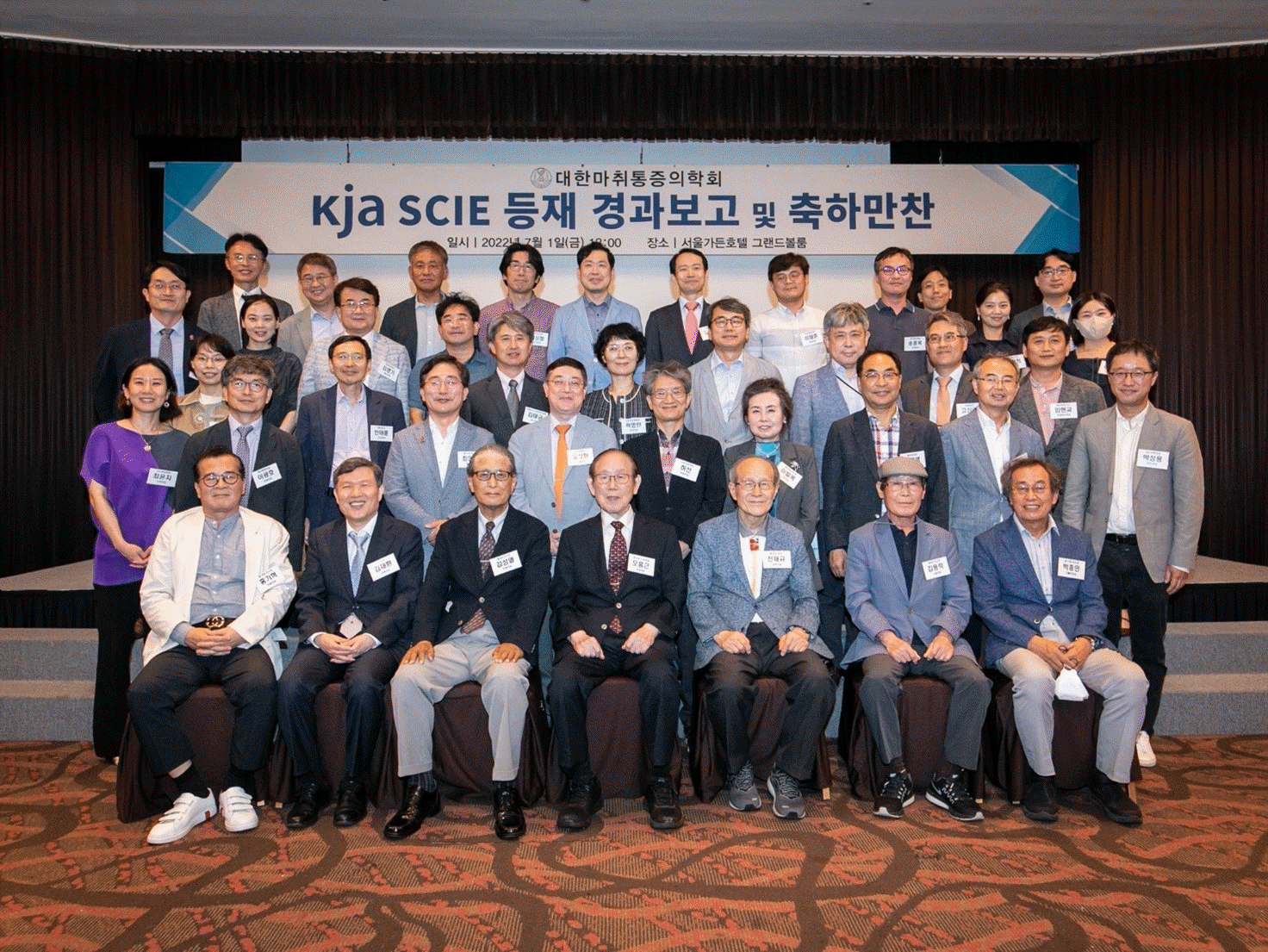
Fig. 2.
Number of articles of the KJA by publication type from 2017 to September 2022 based on the Web of Science Core Collection. *It includes corrections, retracted publications, and retractions [cited 2022 September 11]. KJA: Korean Journal of Anesthesiology.
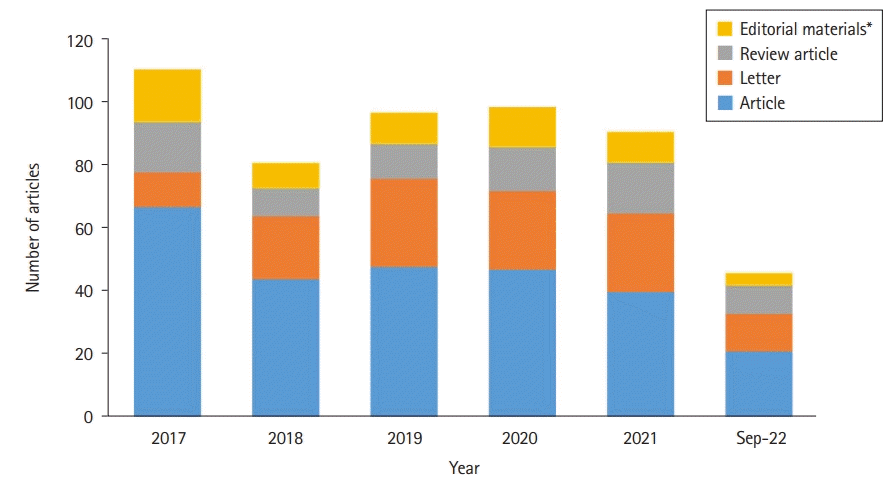
Fig. 3.
Word cloud of the 50 most frequent words (Keywords Plus) used in articles published in the KJA from 2017 to September 2022 based on the Web of Science Core Collection generated from the Authors menu of Biblioshiny [cited 2022 September 11]. KJA: Korean Journal of Anesthesiology.
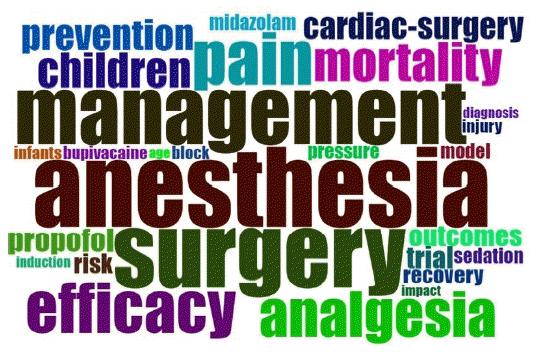
Fig. 4.
Trends in topics of Keywords Plus by year for articles published in the KJA from 2017 to September 2022 based on the Web of Science Core Collection generated from the Document menu of Biblioshiny [cited 2022 September 11]. KJA: Korean Journal of Anesthesiology.
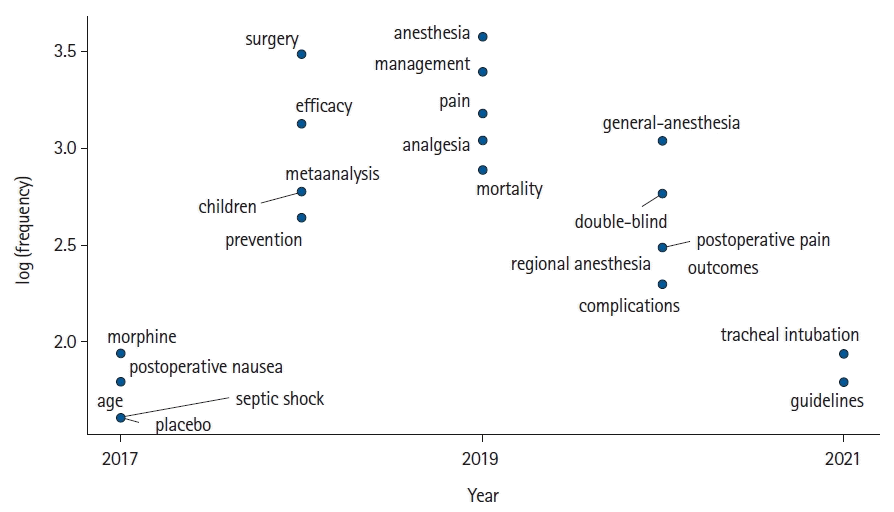
Fig. 5.
Co-occurrence network of Keywords Plus of the KJA from 2017 to September 2022 based on the Web of Science Core Collection, generated from the Document menu of Biblioshiny [cited 2022 September 11]. KJA: Korean Journal of Anesthesiology.
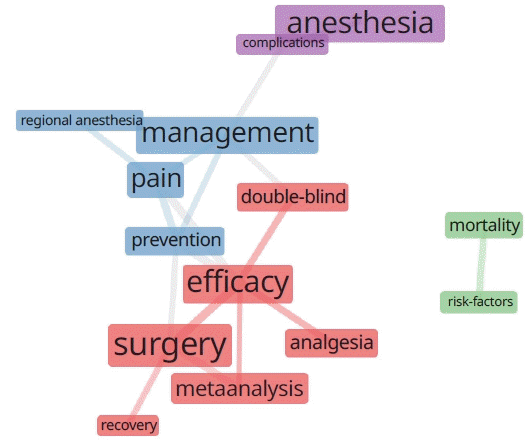
Fig. 6.
Thematic evolution map of Keywords Plus for articles published in the KJA from 2017 to September 2022 based on the Web of Science Core Collection generated from the Conceptual Structure menu of Biblioshiny [cited 2022 September 11]. KJA: Korean Journal of Anesthesiology.
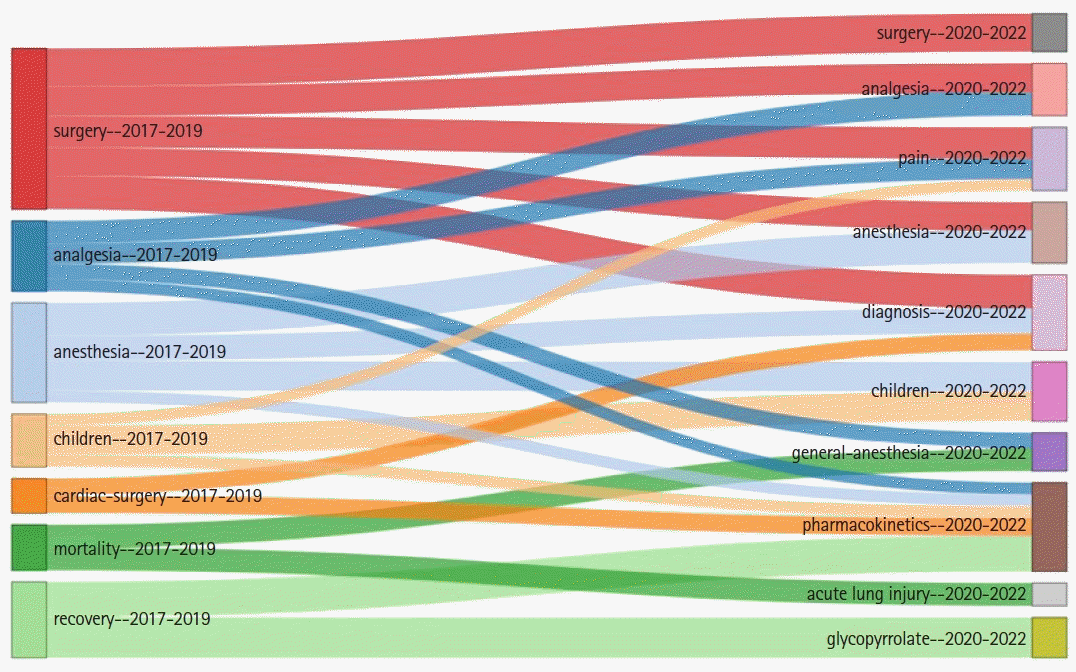
Fig. 7.
Conceptual structure map of Keywords Plus based on multiple correspondence analyses in articles published in the KJA from 2017 to September 2022 based on the Web of Science Core Collection generated from the Conceptual Structure menu of Biblioshiny [cited 2022 September 11]. Dim: Dimension, KJA: Korean Journal of Anesthesiology.
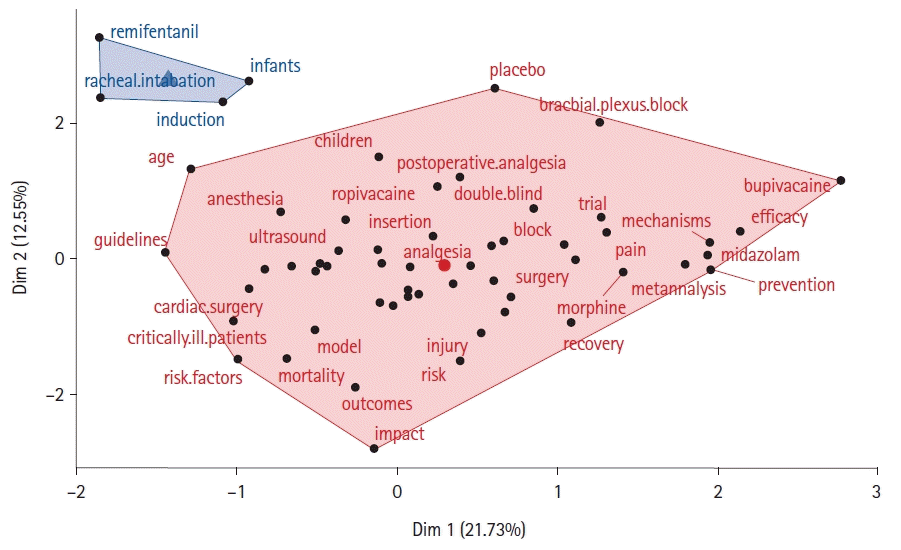




 PDF
PDF Citation
Citation Print
Print



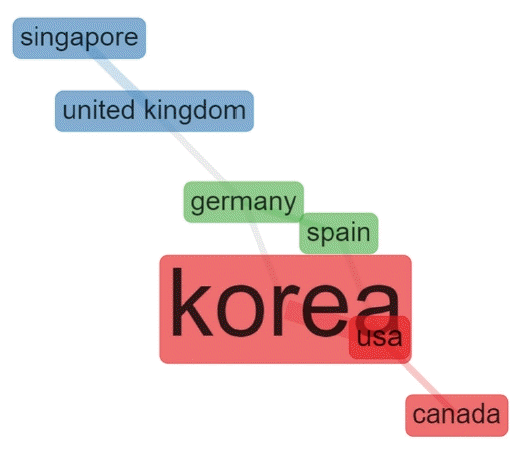
 XML Download
XML Download